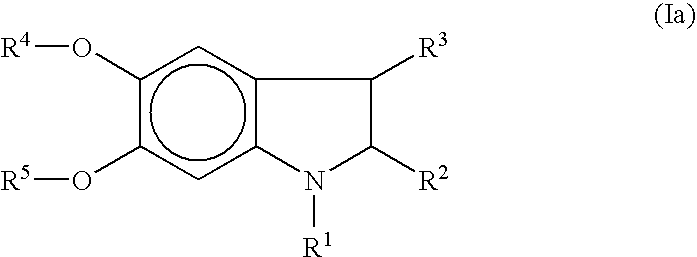Method for coloring hair
a hair color and hair technology, applied in the field of hair color methods, can solve the problems of poor fastness to washing of the obtained colors, insufficient absorption capacity of dye molecules onto the hair, and insufficient shine of colored hair, and the known color methods are still not totally convincing
- Summary
- Abstract
- Description
- Claims
- Application Information
AI Technical Summary
Benefits of technology
Problems solved by technology
Method used
Image
Examples
example 1
[0141]In a volunteer with dark blond hair with very porous tips, the hair was divided by a center parting into a left-hand half and a right-hand half.
[0142]The left-hand half was treated as follows:
[0143]The porous hair tips were sprayed with ca. 15 g of formulation A1. After a contact time of 8 minutes at 25° C., the hair was treated over its entire length with a mixture of 30 g of formulation B1 and 30 g of a 6% aqueous hydrogen peroxide solution. After a contact time of 30 minutes at 25° C., the hair was rinsed with water, shampooed and blow-dried.
[0144]The right-hand half was treated as follows:
[0145]The hair was treated over its entire length with a mixture of 30 g of formulation B1 and 30 g of a 6% aqueous hydrogen peroxide solution. After a contact time of 30 minutes at 25° C., the hair was rinsed with water, shampooed and blow-dried.
Result:
[0146]The left-hand side was uniformly and intensively red in color from the roots to the tips. The right-hand side was less uniformly an...
example 2
[0149]In a volunteer with medium blond hair with very porous tips, the hair was divided by a center parting into a left-hand half and a right-hand half.
[0150]The left-hand half was treated as follows:
[0151]The porous tips were sprayed with ca. 10 g of formulation A2. After a contact time of 7 minutes at 25° C., the hair was treated over its entire length with a mixture of 30 g of formulation B2 and 30 g of a 6% aqueous hydrogen peroxide solution. After a contact time of 30 minutes at 25° C., the hair was rinsed with water, shampooed and blow-dried.
[0152]The right-hand half was treated as follows:
[0153]The hair was treated over its entire length with a mixture of 30 g of formulation B2 and 30 g of a 6% aqueous hydrogen peroxide solution. After a contact time of 30 minutes at 25° C., the hair was rinsed with water, shampooed and blow-dried.
Result:
[0154]The left-hand side was uniformly and intensively copper in color from the roots to the tips. The right-hand side was less uniformly an...
example 3
[0157]In a volunteer with light blond hair with very porous tips, the hair was divided by a center parting into a left-hand half and a right-hand half.
[0158]The left-hand half was treated as follows:
[0159]The porous tips were sprayed with ca. 7 g of formulation A3. After a contact time of 5 minutes, the hair was treated over its entire length with a mixture of 30 g of formulation B3 and 30 g of a 6% aqueous hydrogen peroxide solution. After a contact time of 30 minutes at 25° C., the hair was rinsed with water, shampooed and blow-dried.
[0160]The right-hand half was treated as follows:
[0161]The hair was treated over its entire length with a mixture of 30 g of formulation B3 and 30 g of a 6% aqueous hydrogen peroxide solution. After a contact time of 30 minutes at 25° C., the hair was rinsed with water, shampooed and blow-dried.
Result:
[0162]The left-hand side was uniformly and intensively gold in color from the roots to the tips. The right-hand side was less uniformly and less intensi...
PUM
| Property | Measurement | Unit |
|---|---|---|
| Percent by mass | aaaaa | aaaaa |
| Percent by mass | aaaaa | aaaaa |
| Percent by mass | aaaaa | aaaaa |
Abstract
Description
Claims
Application Information
 Login to View More
Login to View More - R&D
- Intellectual Property
- Life Sciences
- Materials
- Tech Scout
- Unparalleled Data Quality
- Higher Quality Content
- 60% Fewer Hallucinations
Browse by: Latest US Patents, China's latest patents, Technical Efficacy Thesaurus, Application Domain, Technology Topic, Popular Technical Reports.
© 2025 PatSnap. All rights reserved.Legal|Privacy policy|Modern Slavery Act Transparency Statement|Sitemap|About US| Contact US: help@patsnap.com


